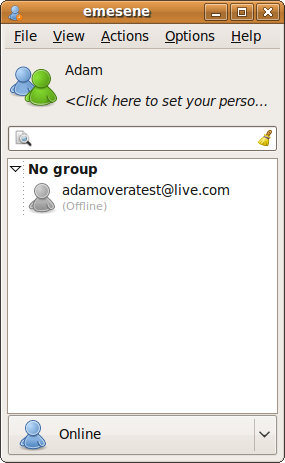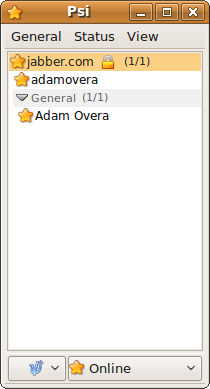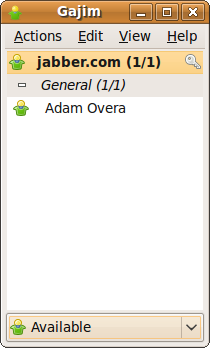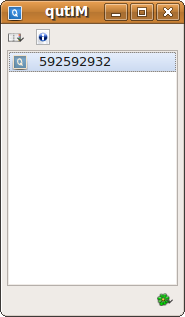Tom's Definitive Linux Software Roundup: Communications Apps
Single-Protocol Instant Messengers
The instant messaging clients in this section only handle a single IM protocol, and are therefore generally more lightweight than their multi-protocol brethren from the previous section. Now you may be asking, “why would anyone choose a client that can only handle one protocol when there are several multi-protocol options available for free?” Good question! This section is going to appeal to people who have a limited need for IM, or have legacy hardware and need all the free system resources they can get. Single-protocol clients also make sense for those who live in countries/regions where almost everyone is using the same protocol. Since there is no point in comparing different IM protocols, I have listed each client under a sub-heading for the protocol it uses, descending by the protocol's popularity.
WLM (formerly MSN) Protocol
Emesene (v. 1.0.1)
Emesene is essentially a clone of the MSN Messenger client and--you guessed it--uses the Windows Live Messenger (WLM) IM protocol. Emesene is basically the same as the old MSN Messenger. Remove the four instances of the letter 'e,' and you're left with 'msn'.
KMess (v. 2.0)
KMess is a WLM (MSN) client for KDE. One feature that sets KMess apart from Emesene (which endeavors to be a straight clone) is the ability to 'nudge' (like a Facebook 'poke') your contacts to see if they are really away. You also have the ability to send files to your contacts over the IM protocol.
Jabber Protocol
Get Tom's Hardware's best news and in-depth reviews, straight to your inbox.
Psi (v. 0.12)
Being available on all three major platforms, as well as having a simple, user-friendly interface, put Psi on the top of this list. Psi easily has the slickest interface of the Jabber IM clients and a right-click on it's system tray icon will present most of it's options in a drop-down menu. Note that it was written in qt, which makes it great for KDE-users.
Gajim (v. 0.12.1)
This is the lightest and fastest jabber IM client. Setting up an account was not a problem for Gajim, and everything is easily accessible via a right-click on the system tray icon. This app was written in GTK, so If you use GNOME, Gajim is a great choice.
Gossip (v. 0.31)
I can only recommend using this app if you have a Jabber account from the official, jabber.org domain. While I was able to chat with contacts on other domains, connection wasn't possible. Gossip was unable to connect using a user ID from jabber.com. After much frustration, I retried using an ID from jabber.org, which connected immediately. Gajim is an all-around better option.
ICQ Protocol
qutIM (v. 0.1)
This app does a good job of cloning the old ICQ client. qutIM even opens in a full-length, thin window on the right side of the screen, which gets irritating. However, it is light and quick. I had no problem getting up and running in qutIM, even though I gave up on ICQ before the turn of the millenium.
Current page: Single-Protocol Instant Messengers
Prev Page Multi-Protocol Instant Messengers Next Page VoIP-
mitch074 I'd like to add something to the article...Reply
- Skype for Linux is currently in version 2.1 (beta) which differs from 2.0 (final) only in the fact that it is now able to deal with ALSA, OSS and PulseAudio transparently - and it doesn't wreck webcam outputs as much.
- Skype for Linux has supported video ever since version 2.0 (beta); it does work quite well if your webcam sends uncompressed video to the system (if your webcam streams MJPEG and you have a 2.6.28+ kernel, you will need some hacker-fu; details on demand)
- a quite well known single protocol IM is aMSN, which is also multiplatform; its other main advantage is that it supports voice and video chats. However, it's not always very stable and requires manual setting up of a TCP port for video and voice to work properly. -
How about benchmarking the applications. Which ones use more ram vs. functionality? How about responsiveness and stability? Those are questions I would like to see laid out because much of the Linux user base have older hardware and don't like things eating away their CPUs and ram.Reply
-
oralward You should really cover something with kde desktop as only because of protest by gnome users is it still the default desktop in any of the three versions you are covering. Its also easier for someone coming from windows. There is a version of ubuntu called Kubuntu that uses kde. This is the other main desktop.Reply -
Great article.Reply
As far as KDE vs. Gnome, I see no problem with the current format, maybe just do a Ubuntu(Gnome) vs. Kubuntu(KDE) vs. Xubuntu(Xfce) vs. MoonOS/OpenGEU/JAD(Enlightenment) roundup, to show off the different desktops(and the few apps that only work on a particular desktop). Any look good with the right theme and some Compiz/Beryl, but KDE and Enlightenment have an edge right out of the box. -
rrockman It's... "Surprising" that you didn't analyze Mercury, one of the most advanced multi-account IM apps.Reply -
haplo602 ah gui only options ... well have a look at CenterIM when you have time. It's a great little IM tool that runs in the terminal. This way I can get to my client everywhere with just a simple ssh client :-)Reply -
"The one major protocol that Empathy supports and Pidgin doesn't is the increaasingly-popular Jabber."Reply
This is just plain wrong. Pidgin has supported Jabber for a long time. It's called XMPP in the later versions which is the name of the protocol used by jabber clients -
rdawise Again, I praise Mr. Overa's coverage of Linux. I am looking forward to the Games section of Linux since I don't have much experience with native games.Reply -
jppayne2 "My major problem with Thunderbird is that it will continually ask for confirmation to ignore a security certificate every time it checks for new mail, by default, every ten minutes. Most of the other clients in this roundup give you the option to always accept or ignore."Reply
Actually, Thunderbird allows you to permanently accept the certificate, which will do what you want. Just pay attention when the confirmation dialog comes up, and select "Accept this certificate permanently". It's the first option (the default is the second option, which is to accept the certificate for the current session).






























